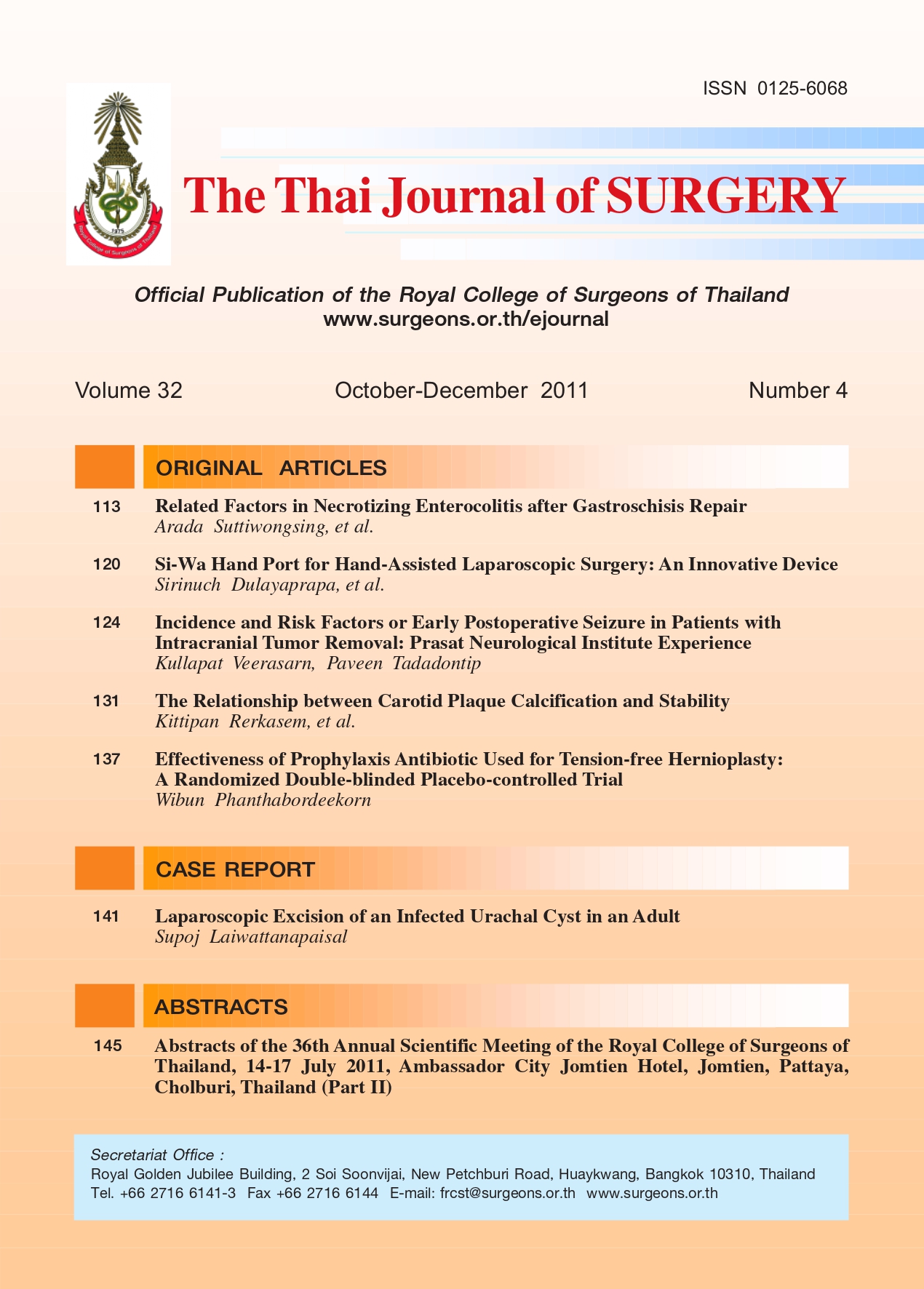The Relationship between Carotid Plaque Calcification and Stability
Keywords:
calcification, carotid, plaque, atherosclerosis, instabilityAbstract
Aim: The study aimed to examine the hypothesis that advanced plaques with calcification are more stable(lower proportion of lipid component and higher proportion of fibrous tissue) compared to plaques without
calcification.
Methods: Carotid endarterectomy (CEA) specimens from 141 consecutive patients were studied. The
specimens were analyzed histologically for fibrous tissues, smooth muscle cells, macrophage, lymphocyte,
hemorrhage and lipid, according to the methods of European Carotid Plaque Study Group; plaques were also
graded according to American Heart Association (AHA) consensus and its modification. Clinical data was
recorded and the plasma concentrations of cholesterol and inflammatory markers were measured.
Results: Thirty five out of 141 plaque specimens were identified to have advanced atherosclerosis (type
V according to AHA criteria) and these were analyzed further. There were 29 type Va (non-calcified) plaques
and 6 type Vb (calcified) plaques. Calcified plaques had significantly less lipid than non-calcified plaques (p
< 0.0001): the mean percentage of lipid for non-calcified and calcified plaques was 61.29% and 23.48%,
respectively. Also calcified plaques had more fibrous tissue than non-calcified plaques (p = 0.004): the mean
percentage of fibrous tissue for non-calcified and calcified plaques was 23.74% and 59.37%, respectively
(P<0.0001). The 6 calcified plaques showed no inflammatory cell infiltrate and did not exhibit thin fibrous cap
atheroma which are the characteristics indicating high risk for plaque rupture.
Conclusion: Calcified plaques had significantly less lipid and more fibrous tissue than non-calcified
plaques. These findings might suggest indirectly that plaque calcification is a marker of plaque stability. This
may be a useful clinical tool to identify asymptomatic carotid stenosis patients with high risk plaques, which
could improve benefit of CEA.
References
symptomatic carotid stenosis. Cochrane Database Syst
Rev 2011;13:CD001081.
2. Endarterectomy for asymptomatic carotid artery stenosis.
Executive Committee for the Asymptomatic Carotid
Atherosclerosis Study. JAMA 1995;273:1421-8.
3. Prevention of disabling and fatal strokes by successful carotid
endarterectomy in patients without recent neurological
symptoms: randomised controlled trial. MRC Asymptomatic
Carotid Surgery Trial (ACST) Collaborative Group. Lancet
2004;363:1491-502.
4. Virmani R, Finn AV, Kolodgie FD. Carotid plaque stabilization
and progression after stroke or TIA. Arterioscler Thromb Vasc
Biol 2009;29:3-6.
5. Rerkasem K, Gallagher PJ, Grimble RF, Calder PC, Shearman
CP. Sex difference in composition of plaques of patients
undergoing carotid endarterectomy. Vascular 2010;18:77-
81.
6. Stary HC, Chandler AB, Dinsmore RE, et al. A definition of
advanced types of atherosclerotic lesions and a histological
classification of atherosclerosis. A report from the Committee
on Vascular Lesions of the Council on Arteriosclerosis,
American Heart Association. Arterioscler Thromb Vasc Bio
1995;15:1512-31.
7. Virmani R, Kolodgie FD, Burke AP, Farb A, Schwartz SM.
Lessons from sudden coronary death: a comprehensive
morphological classification scheme for atherosclerotic
lesions. Arterioscler.Thromb Vasc Biol 2000;20:1262-75.
8. Carotid artery plaque composition—relationship to clinical
presentation and ultrasound B-mode imaging. European
Carotid Plaque Study Group. Eur J Vasc Endovasc Surg
1995;10:23-30.
9. Wahlgren CM, Zheng W, Shaalan W, Tang J, Bassiouny HS.
Human carotid plaque calcification and vulnerability.
Relationship between degree of plaque calcification, fibrous
cap inflammatory gene expression and symptomatology.
Cerebrovasc Dis 2009;27:193-200.
10. Shaalan WE, Cheng H, Gewertz B, et al. Degree of carotid
plaque calcification in relation to symptomatic outcome
and plaque inflammation. J Vasc Surg 2004;40:262-9.
11. Nandalur KR, Hardie AD, Raghavan P, Schipper MJ, Baskurt
E, Kramer CM. Composition of the stable carotid plaque:
insights from a multidetector computed tomography study
of plaque volume. Stroke 2007;38:935-40.
12. Li ZY, Howarth S, Tang T, Graves M, King-Im J, Gillard JH. Does
calcium deposition play a role in the stability of atheroma?
Location may be the key. Cerebrovasc Dis 2007;24:452-9.
13. Li ZY, Howarth S, King-Im J, Gillard J. Atheroma: is Calcium
important or not? A modelling study of stress within the
atheromatous fibrous cap in relation to position and size of
calcium deposits. Conf Proc IEEE Eng Med Biol Soc 2005;3:
2236-9.
14. Kwee RM. Systematic review on the association between
calcification in carotid plaques and clinical ischemic
symptoms. J Vasc Surg 2010;51:1015-25.
15. Geng YJ, Wu Q, Muszynski M, Hansson GK, Libby P. Apoptosis
of vascular smooth muscle cells induced by in vitro stimulation
with interferon-gamma, tumor necrosis factor-alpha, and
interleukin-1 beta. Arterioscler Thromb Vasc Biol 1996;16:19-
27.
16. Libby P. Molecular bases of the acute coronary syndromes.
Circulation 1995;91:2844-50.
17. Boyle JJ, Bowyer DE, Weissberg PL, Bennett MR. Human
blood-derived macrophages induce apoptosis in human
plaque-derived vascular smooth muscle cells by Fas-ligand/
Fas interactions. Arterioscler Thromb Vasc Biol 2001;21:1402-
7.
18. Wilcox JN, Smith KM, Schwartz SM, Gordon D. Localization
of tissue factor in the normal vessel wall and in the
atherosclerotic plaque. Proc Natl Acad Sci USA 1989;86:2839-
43.
19. Kadoglou NP, Gerasimidis T, Golemati S, Kapelouzou A,
Karayannacos PE, Liapis CD. The relationship between
serum levels of vascular calcification inhibitors and carotid
plaque vulnerability. J Vasc Surg 2008;47:55-62.
20. Zhao XQ, Yuan C, Hatsukami TS, et al. Effects of prolonged
intensive lipid-lowering therapy on the characteristics of
carotid atherosclerotic plaques in vivo by MRI: a casecontrol
study. Arterioscler Thromb Vasc Biol 2001;21:1623-9.
Downloads
Published
How to Cite
Issue
Section
License
Articles must be contributed solely to The Thai Journal of Surgery and when published become the property of the Royal College of Surgeons of Thailand. The Royal College of Surgeons of Thailand reserves copyright on all published materials and such materials may not be reproduced in any form without the written permission.



